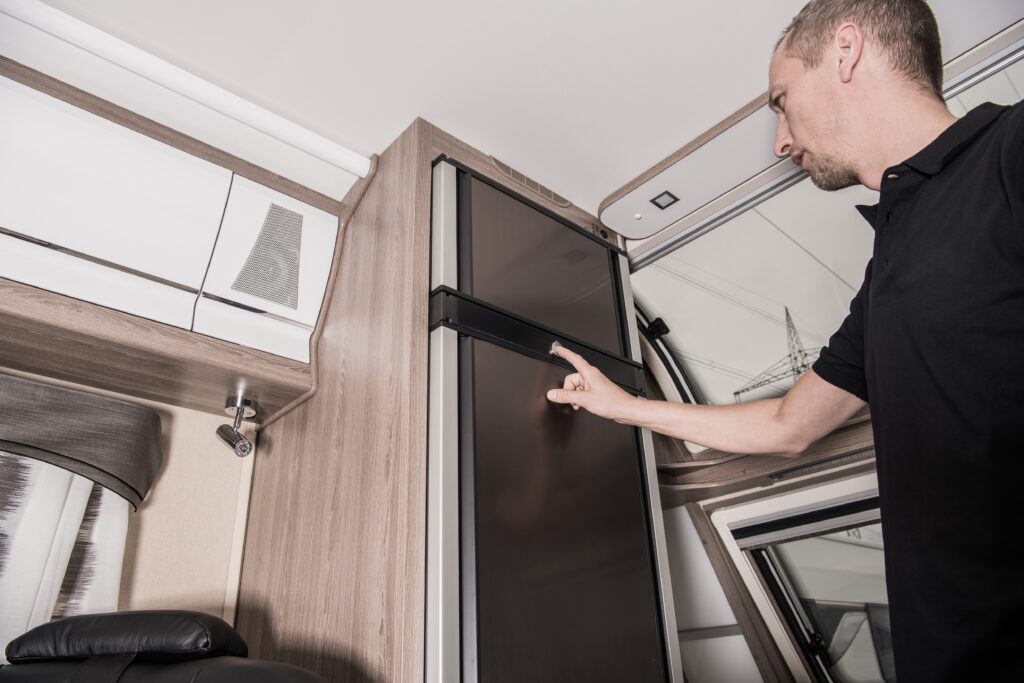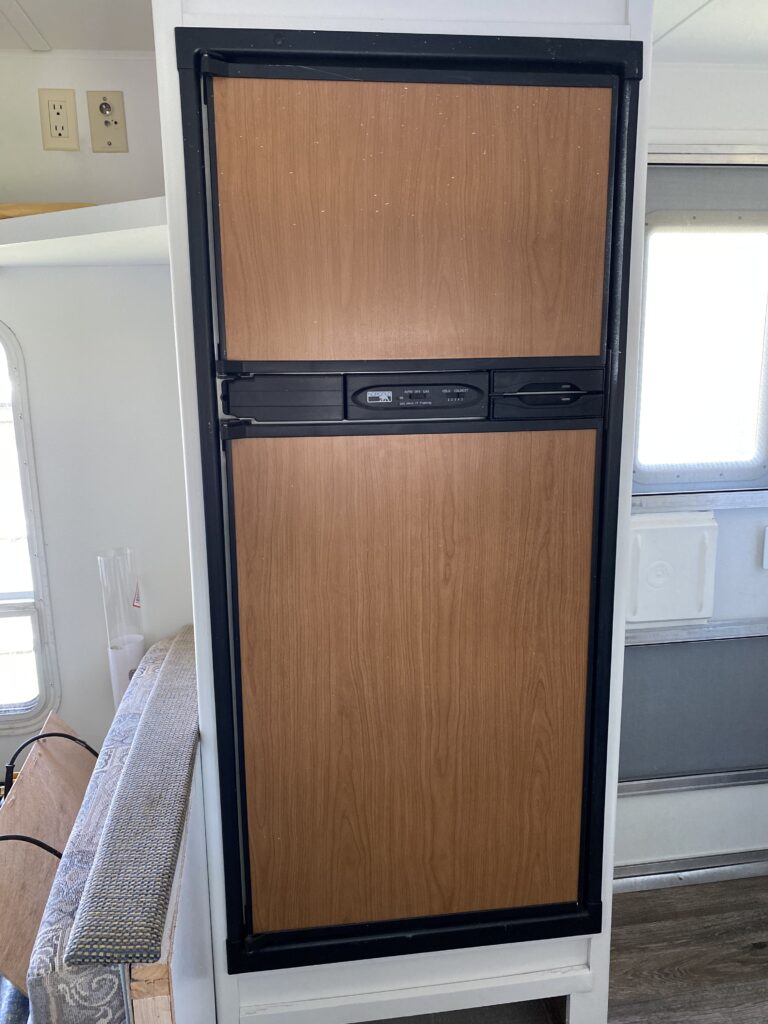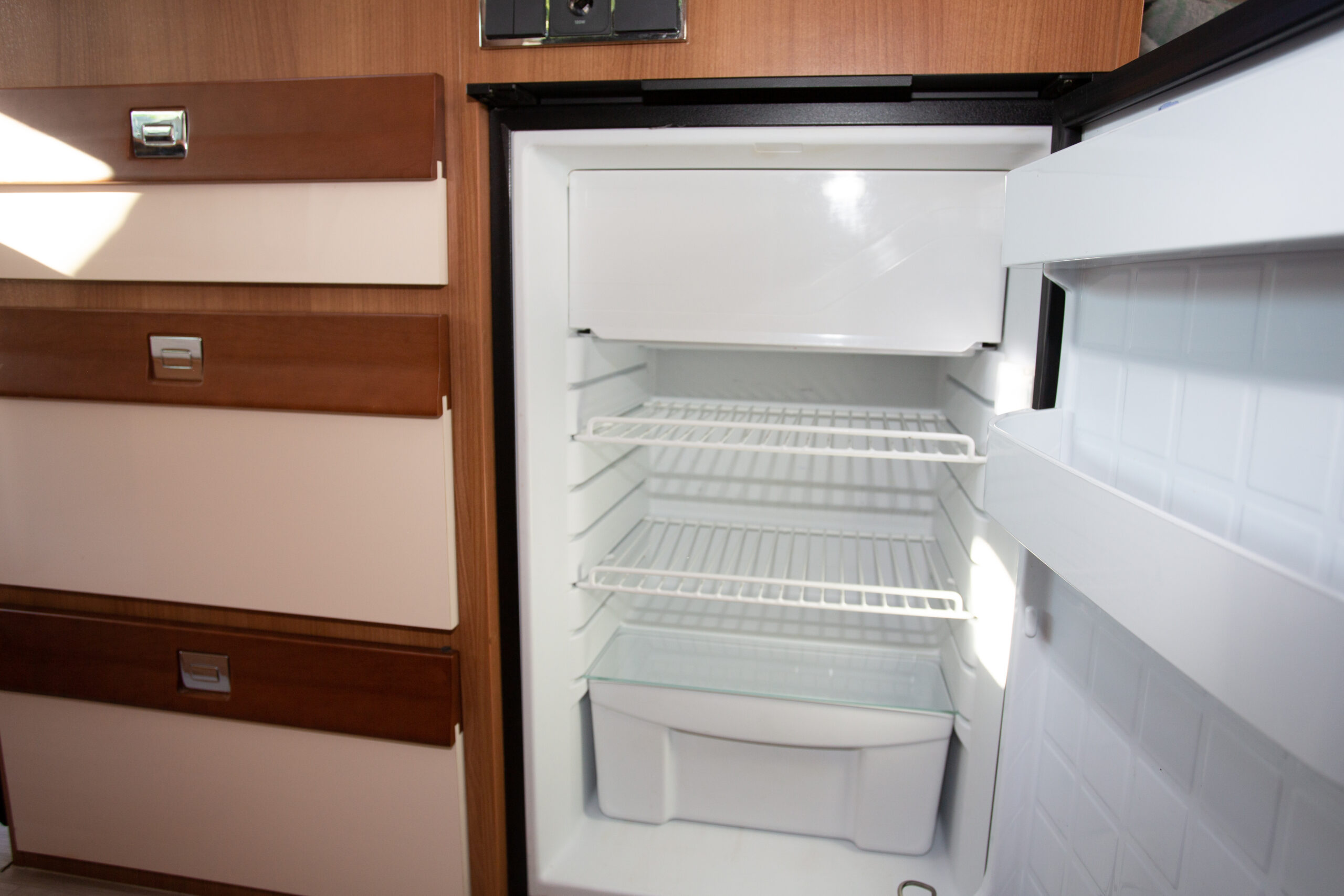Recreational vehicles (RVs) offer the excitement of a mobile lifestyle combined with many comforts of home, including an essential kitchen feature: the refrigerator. RV refrigerators differ from their household counterparts as they can be powered by gas or electricity, providing flexibility and convenience on the road. Understanding how to use an RV refrigerator in various modes ensures a more efficient and enjoyable camping experience.
RV refrigerators have the capacity to run on propane gas or shore power electricity, making them versatile appliances for travelers who frequently park in off-grid locations or campgrounds. Switching between gas and electric modes can be done easily, as most RV refrigerators come equipped with a display on the front panel that allows for selection between LP (propane) mode or auto mode. Choosing auto mode enables the fridge to efficiently alternate between power sources as needed.
Learning to operate an RV refrigerator in both gas and electric modes not only optimizes the device’s energy consumption but also aids in food preservation during trips where power sources may change or when boondocking in remote areas. A well-functioning fridge contributes to an enjoyable RV experience, providing cold sustenance for memorable outdoor adventures.
Types of RV Refrigerators
When it comes to keeping food and beverages cold in your RV, there are two main types of refrigerators to choose from: absorption refrigerators and compressor refrigerators. Both types have their advantages and drawbacks, which will be covered in this section.
Absorption Refrigerators
Absorption refrigerators, also known as 2-way or 3-way fridges, are the most common type of RV refrigerator. They can run on different power sources, such as AC Power, LP gas, and DC Power, making them very versatile for RVers who travel to different locations with varying power availability.
A 2-way RV refrigerator can operate on AC power (shore power or a generator) or LP gas, while a 3-way refrigerator can also use DC power from the RV’s house batteries. This feature offers the flexibility of switching to propane to conserve power when electricity is not readily available, or using DC power when both propane and AC power are scarce. However, absorption refrigerators tend to be less energy-efficient than their compressor counterparts and may not cool as effectively in particularly hot environments.
Compressor Refrigerators
Compressor refrigerators, also known as residential refrigerators, operate on 120V AC electricity. These fridges are becoming more popular in newer RV models due to their increased energy efficiency and better cooling performance compared to absorption refrigerators. When using a compressor refrigerator in an RV, a 12V DC power from your RV’s house battery bank is converted to 120V AC power by an inverter.
Although compressor refrigerators often provide more consistent cooling and better energy efficiency, particularly in hot temperatures, they do not offer the same flexibility of power source options as absorption refrigerators. These types of fridges will require a constant supply of AC power, making them less suitable for those who boondock or spend extended time off-grid.
In summary, absorption refrigerators provide more flexibility in power source options, while compressor refrigerators offer better cooling performance and energy efficiency. Your choice of RV refrigerator may depend on factors such as where you typically camp, available power sources, and personal cooling requirements.
How RV Refrigerators Work
An RV refrigerator uses a combination of propane gas, electricity, and ammonia in order to work efficiently and effectively. The functioning of these refrigerators can be dependent on either gas or electrical energy, but they often use a combination of both when it is available. In this section, we will cover gas and electric operation and how they differ from one another.
Gas Operation
Gas absorption refrigerators in RVs use propane as the main power source to keep the food cool. The process begins when propane is burned in the pilot light, generating heat. This heat is then absorbed by the cooling unit, which contains ammonia. When ammonia is heated, it changes from its liquid form to a gas, allowing it to circulate and absorb more heat, maintaining the cool temperature inside the refrigerator.
One major advantage of using propane is its availability and efficiency in off-grid situations. Since propane can be easily stored and transported, RV users can keep their refrigerators functioning even when electricity is not available. However, always ensure proper ventilation is present to prevent the build-up of harmful gases in the RV.
Electric Operation
Electric RV refrigerators make use of an electric heating element to generate the heat required to keep the cooling unit functioning. Similar to gas operation, ammonia is once again the key substance in absorbing and transferring heat within the cooling unit. As the electric heating element warms up, it heats the ammonia, causing it to evaporate and move throughout the cooling unit, which lowers the inside temperature of the refrigerator effectively.
Electric RV refrigerators can be powered by either shore power when connected to an electrical grid or through on-board batteries when boondocking. They provide a reliable and energy-efficient alternative to propane refrigerators but require electricity to function.
In conclusion, understanding the functioning of RV refrigerators in gas and electric modes allows RV users to make informed decisions about how best to utilize their appliances while traveling. By selecting the right operating mode and maintaining their cooling units, RV users can rest assured that their refrigerators will be able to keep their food and beverages at optimum temperatures during their trips.
Powering Your RV Refrigerator

Propane Gas
Many RV refrigerators can be powered by propane gas as a fuel source. Using propane is an efficient and convenient way to keep your food cold while traveling, especially when you’re camping off-grid or away from electric hookups. To use propane, you’ll need to connect your refrigerator to a propane tank or an LP gas tank. Once connected, the propane flow is regulated, and the fridge starts cooling. Keep in mind that using propane requires proper ventilation to avoid any dangerous gas buildup.
Using propane to power your RV fridge can be very energy-efficient. For example, an RV fridge rated at 1500 BTUs per hour could run for roughly 61 hours off 1 gallon of propane.
Electric Power and Shore Power
Electric power is another common method for powering your RV refrigerator. These fridges can operate using either 120-volt AC or 12-volt DC power. When you have access to an AC electrical grid, such as at a campsite with hookups or a friend’s house, you can use shore power to run your electric refrigerator. Shore power is typically available in 30-amp or 50-amp connections.
Keep in mind when connecting to a residential electrical grid to exercise caution and consider using an adapter to avoid electrical overloads or damage to your RV’s electrical system.
Battery and Solar Power
Battery power, specifically 12-volt batteries, can also be used to power an RV refrigerator. However, relying solely on battery power can quickly drain the batteries, so it’s essential to recharge them regularly using methods like solar power or a generator. Additionally, 12-volt DC power is often not as efficient as other power sources like propane, and it will typically take longer for your fridge to cool.
Solar power can complement battery power by continuously recharging the batteries during daylight hours. By investing in solar panels for your RV, you can potentially extend the time you can use your refrigerator without needing to recharge the batteries through other means.
Remember to consider the efficiency of these alternative methods and balance them as needed to keep your RV refrigerator running optimally without sacrificing power sources for other essential RV systems.
Using Your RV Refrigerator
Switching Between Gas and Electric
An RV refrigerator can be powered by both gas and electricity. To switch between these power sources, locate the control panel on your fridge and choose the desired mode, typically labeled as “Auto,” “Gas,” or “Electric.” In Auto mode, the refrigerator will automatically choose the best power source available – propane gas or electric power. If you’d like to use propane, select the Gas mode. To use electric power, choose the Electric setting.
Adjusting the Temperature
Once your RV fridge is powered on, you may want to adjust the temperature to suit your needs. Most RV refrigerators come with a temperature dial, allowing you to set the desired temperature for both the fridge and freezer compartments. It typically takes about 8-12 hours for the fridge to reach its set temperature[^2^]. Keep in mind that putting warm or room-temperature items in the fridge can slow down the cooling process. Also, be aware that gas-electric fridges can take 3-6 hours to cool down once you start them.
Proper Food Storage
To maximize the efficiency of your RV refrigerator, it’s important to properly store your food inside. Here are some tips to help you organize your fridge effectively:
- Make use of the interior space by adjusting shelves and dividing food into categories, such as fruits, vegetables, meats, dairy, etc.
- Store drinks on the bottom shelf to help reduce the risk of spills.
- Place perishable items, such as meats and dairy products, in colder areas of the fridge, typically found near the back or on the middle shelf.
- Prevent overstuffing, as this can reduce the efficiency of your fridge. Assign specific areas for different food groups, keeping frequently accessed items near the front to minimize the need to keep the fridge door open.
- Freezers in RV refrigerators are usually not as powerful as residential freezers, so be cautious when storing highly perishable items that require very low temperatures.
Remember to monitor the temperature of your fridge regularly and make adjustments as needed, especially when adding or removing large amounts of food. Enjoy your well-organized and efficient RV refrigerator!
Maintenance and Troubleshooting
Routine Maintenance
Regular maintenance of your RV refrigerator, whether it’s a Dometic or Norcold model, is essential for optimal performance. Keep the refrigerator clean, both inside and outside, by wiping down surfaces with mild detergent. Ensure proper airflow by periodically checking the vents for debris or obstruction.
It’s also recommended to:
- Defrost the freezer regularly to prevent ice buildup.
- Inspect the seals around the doors to ensure they’re not cracked or damaged.
- Level your RV for optimal refrigerator performance, as these appliances rely on gravity to function properly.
- Monitor the temperature with thermometers designed for refrigerator use.
Common Issues and Repairs
Several issues might affect your RV refrigerator’s performance. The most common problems include:
- Cooling Unit Failure: If you notice a strong ammonia odor, it might indicate a punctured cooling unit. In these cases, it’s often more practical to replace the entire refrigerator rather than attempt a costly repair.
- Insufficient Airflow: The lack of proper airflow can cause inadequate cooling. Make sure the vents are clean and unobstructed, and that there is enough space around the refrigerator for air to circulate.
- Electricity/Propane Issues: Ensure that the refrigerator is receiving sufficient power. If running on propane, check the gas valve, ignitor, and LP gas line for proper function. Sometimes, propane systems may need to be reset if they have gone into a lockout after several unsuccessful ignition attempts.
When to Call a Technician
Although some troubleshooting can be done by RV owners, certain issues require the expertise of a trained technician. If you’re uncertain about the problem or feel uncomfortable attempting a repair, it’s best to consult a professional. Remember that safety should always be the top priority when dealing with appliances that run on electricity or propane.
Safety and Efficiency Tips
When using an RV refrigerator, whether gas or electric, it’s important to keep a few safety and efficiency tips in mind. Proper use of appliances can help ensure a comfortable and convenient camping experience, especially while boondocking without access to shore power.
Firstly, make sure the refrigerator is the right size for your RV. A well-fitting fridge maximizes space and improves energy efficiency. Stainless steel materials are not only aesthetically pleasing but also contribute to better insulation and durability.
For gas-electric refrigerators, remember that they run off propane tanks and require an electric heating element or LP gas flame to function. Therefore, routinely check propane tanks for leaks and ensure the thermocouple – a safety device that shuts off the gas supply in case of flame failure – is working correctly.
Only run gas-electric refrigerators on propane if you lack access to shore power. Electric fridges can work on both 120-volt AC power and 12-volt DC power from the battery. Keep in mind that an absorption fridge running solely on a 12-volt battery might deplete the battery faster.
To maintain efficiency, remember a few key points:
- Don’t overstuff the fridge, as RV fridges work best with some empty space for air to circulate.
- Make sure the refrigerator is level, as this affects cooling efficiency.
- Pre-cool items like water bottles or use ice packs to help speed up the cooling process.
Following these safety and efficiency tips can help you get the most out of your RV refrigerator and ensure a pleasant camping experience. Happy travels!
Exploring Better Options
When it comes to refrigerating food in an RV, owners have numerous options that cater to various needs and preferences. This section delves into the advantages and considerations associated with residential RV refrigerators, as well as highlights some reliable top brands.
Residential RV Refrigerators
Residential RV refrigerators are designed to mimic the efficiency and usage of household appliances, providing comfort and familiarity for RV users. These refrigerators typically operate on electric power, offering better performance in reaching the desired temperature quickly. This can be particularly beneficial for those who frequent RV parks or campgrounds with electric hookups.
Another key advantage of residential RV refrigerators is their increased efficiency. Electrical refrigerators tend to consume less energy than propane-powered ones, making them an eco-friendly option for those concerned about their carbon footprint.
However, it’s worth noting that residential RV refrigerators might not be the best choice for off-grid explorers. Without access to a reliable power source, such as in remote boondocking locations, propane-powered refrigerators become a more practical option to maintain food freshness.
Reliable Top Brands

There are several brands that stand out for producing high-quality, reliable RV refrigerators. Some of the top contenders include Dometic, Norcold, and Furrion. Each brand offers a range of models to fit various RV sizes, power requirements, and personal preferences.
Dometic is known for its versatile propane/electric fridges, allowing users to switch between gas and electric modes to adapt to different power sources. Likewise, Norcold offers dual-powered refrigerators, ensuring the cooling system remains functional in various RV settings.
Lastly, Furrion is a noteworthy brand specializing in efficient electrical refrigerators. With an emphasis on sleek design and energy conservation, Furrion’s products cater to RV owners looking for stylish and eco-friendly refrigeration solutions.
An informed choice of an RV refrigerator ultimately comes down to individual needs and intended usage, whether it be mainly in RV parks, off-grid locations, or a mix of both. By exploring residential refrigerators and familiarizing themselves with reliable brands, RV owners can find the right cooling solution to suit their lifestyles.
Final Thoughts
As an RV enthusiast, one of the essential aspects to master is the operation of your RV refrigerator. These appliances can run on either gas (propane) or electricity, offering flexibility and convenience for your travels. Knowing how to use each mode will ensure your food stays fresh and safe during your journey.
An RV refrigerator operates using different power sources such as propane, 120-volt AC, or 12-volt DC. A common recommendation is to use the “auto mode,” which allows the refrigerator to switch between power sources depending on availability. This can save fuel and energy without sacrificing performance.
When it comes to the gas-electric refrigerator, using propane is an excellent choice for those who travel frequently or boondock. Propane provides a reliable and efficient cooling method while remaining independent from shore power. However, remember to follow safety guidelines and maintain your propane system to avoid potential issues.
In addition to power source choices, RV refrigerator maintenance is crucial for its longevity and performance. Ensuring proper ventilation, regularly defrosting the unit, and keeping the door seals clean will contribute to a well-functioning refrigerator throughout your travels.
Overall, understanding how to use and maintain your RV refrigerator on both gas and electric power contributes to a better RV experience. By mastering this essential aspect, you’ll be well on your way to enjoying fresh, perfectly chilled food and beverages during your RV adventures.






